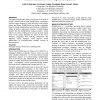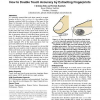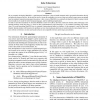16160 search results - page 59 / 3232 » How to approach humans |
CHI
2003
ACM
14 years 8 months ago
2003
ACM
This paper describes the results of a Wizard of Oz study of people's search behavior using BuddySystem, a proximitysensing system designed to help end-users locate people, pl...
CHI
2010
ACM
14 years 2 months ago
2010
ACM
When designing novel GUI controls, interaction designers are challenged by the “immaterial” materiality of the digital domain; they lack tools that effectively support a refle...
CHI
2010
ACM
14 years 2 months ago
2010
ACM
It is generally assumed that touch input cannot be accurate because of the fat finger problem, i.e., the softness of the fingertip combined with the occlusion of the target by the...
CHI
2007
ACM
13 years 12 months ago
2007
ACM
A prototype of computing technology--as a means to evaluate and communicate a good idea--is often an essential step towards useful, shipping products and towards a deeper understa...
LREC
2008
13 years 9 months ago
2008
We are currently developing MiniSTEx, a spatiotemporal annotation system to handle temporal and/or geospatial information directly and indirectly expressed in texts. In the end, t...




